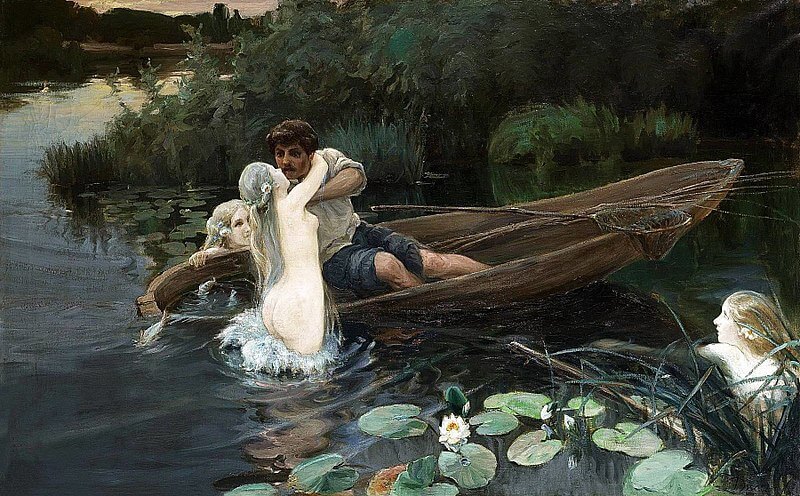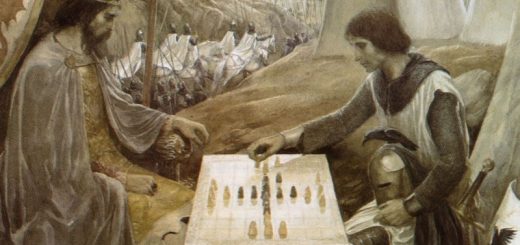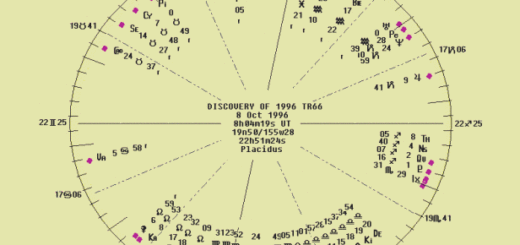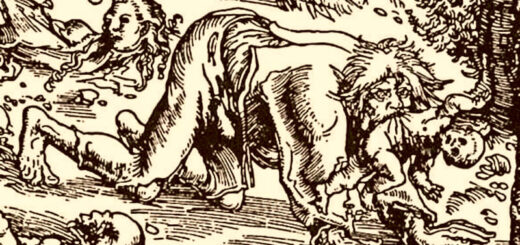Water spirits of Eastern Europe
Water spirits hold an important position in Eastern European folklore. Within Slavic lore, the Rusalka and Vodyany or Wodnick are about the only creatures known beyond Slavic countries. This is mainly due to the early 20th century illustrations by Russian artist Ivan Yakovlevich Bilibin (1876-1942), which, like his other drawings, found their way to Instagram, Pinterest and Tumblr. Eastern Europe has real many more types of water spirits, of which we show an overview below.
Water spirits in folklore should often be distinguished from Water-elementals, such as the Undines, although there are unclear transitional forms in European folklore, such as the Nixen or Necken, the German Wassermänchen, etc.
The Water spirits of Eastern Europe (and some in Southern Europe) can sometimes be traced back to the Greek water and spring nymphs. Remarkably often it are the spirits of drowned people, especially women, who have evolved into water spirits. Usually these spirits are then as seductive as they are malevolent, trying to lure men to drown them.
Bagienniki
Bagienniki are lesser known water spirits in Slavic folklore. They were akin to the bathhouse spirit Bannik. and ruled by Wąda, lady of the lakes and the shallow streams, also known as the Queen of the Underwater Lawns. The influence of Bagienniki on humans was regarded as mostly positive. They usually stayed at the bottom of shallow swamps and ponds and only occasionally emerged from the surface of the mud to take a breath.
Boginka
Boginka (goddess; pl.: Boginki) in pre-Christian Slavic beliefs was a female demon, a personification of natural forces, hostile to humans. Later she is often equated with Dzvozhona, Mamuna and Rusalka. The name is derived from the word bóg/bogini (god/goddess).
With time, in popular belief, the term goddess was replaced by the borrowed term Rusalka, and people began to identify the Boginka also with other demonic spirits, such as Strzygami, Dziwożonami, Topielicami, Mamunami. The Boginki lived in swamps, lakes, rivers, forests and mountains.
They could be found near the water while washing scarves with wooden tadpoles.
Bolotnitsa
In the Russian North it is believed, that Bolotnitsa or Bolotnica is the mistress of the swamp and tundra.
Like the Bolotnik, there are many different descriptions of her. In some legends she is a Rusalka (or Rusalka’s sister). It was believed, for example, that a girl, who had died in a swamp or was carried away by an unclean spirit, could turn into the Bolotnitsa.
In some places the Bolotnitsa was considered to be more like a nature spirit that had no connections with the human race. A Bolotnitsa was usually portrayed as a beautiful young girl with pale-white skin and goose legs instead of normal legs.
To hide them, the Bolotnitsa would sit on a giant water lily, putting her legs under her.
She would lure people into the swamp with a weep for help, pretending that she is drowning. If they were charmed by her beauty, people would get close to her. She would then pounce on them and slowly pull them to the bottom of the swamp.
Brodarica
The Brodarica or Brodavica is a female Slavic demon of Serbo-Croatian and Bulgarian folklore. She was believed to be a genus of Vila. She inhabited bodies of water – mainly fords and shallows, which she guarded and protected from men.
Brzeginia
In Slavic folklore Brzeginia or Brzeginka was originally a female demon inhabiting the shores of water-bodies and mountains and guarding treasures hidden underground. Later on this role was taken over by the Rusalka.

Jacek Malczewski – Załaskotany (1888). Polish painter Malczewski had a special interest in the folk tales and legends of central Europe. His Rusałki Cycle tells stories about the Rusalki, and in Załaskotany , he shows a whole group of these water spirits laughing at the way that they tricked the boy in the centre foreground, who appears to have drowned as a result of their malicious prank.
Chichiga
The Chichiga (Russian: шиши́га, also named Lechenka, ле́шенка) is a female goblin-like creature in Russian folklore and Slavic mythology. She is described as a small hunchbacked being, living in reeds, with a preference for small streams and ponds.
According to tradition, she walks around naked and with her hair down, harassing passers-by, especially drunks. She sleeps all afternoon and appears only at dusk.
Chichiga plays an important role in the mythology of the Komis – a Finno-Ugric people of Russia, living mainly in the Komi Republic – according to whom she lives in the river Kama, which she sometimes leaves to sit on the riverbank and comb her long black hair.
Seeing a Chichiga is fatal. Anyone who spots the creature will soon die of drowning or some other cause.
Ćmuch
A Ćmuch is a Slavic Water-Sprite or Marsh-demon, found in legends of the Laskowiak people from the Tarnobrzeg area, in Subcarpathian Poland. This slothful creature lives in water reservoirs and marches or in their vicinity.
It looked like a huge frog with small round ears and it had a short, slightly curled, pointed tail. According to lore he always sat in a crouch.

Vodyanoy on old Russian postcard – before 1917
Karakondjul
The Karakondjul is a Bulgarian demon (also: Karakondjol). It is reputed to dwell in caves, or rivers, or an abandoned water mill, and come out at night. The description of the creature varies a lot.
It is described as being human-like except for having a hairy body, a tail, and a large head with horns on it, or a one-eyed being standing on a single leg, or a horse-headed man.
Nëczk
In Kashubian folklore the Nëczk is a Wassermann (a kind of water-sprite) living in the Baltic Sea, and the Pomeranian lakes and rivers. He is credited with creating whirlpools and water currents that are dangerous to swimmers.
Pereplut
Pereplut is a rather mysterious deity or demon of the East Slavs with an unclear function, though it was probably a water-spirit.
Pereplut appears in the list of gods and demons of the 15th-century Ruthenian Interpolation of the Word of St. Grigory, as well as in the Word of St. John.
According to this last source pagan Slavs worshiped deities or daemons like: Vila, Mokosh, Dziwa, Perun, Hors, Rozhanitsy, ghosts and Pereplut.
Pereplut was most likely a daemon whose task it was to ensure prosperity when crossing a river, hence his identification as a water deity, which is supported by the etymology of the words pere- “through” and pluti-“to flow”.

Rusalki by Iwan Nikolajewitsch Kramskoj, 1871
Rokita
Rokita is the name of a famous devil in Polish folk tales. He is characterized by unimaginable strength, but is not very cunning. He inhabits areas that are associated with gates to the afterlife. These include swamps, forests, and above all, the interiors of old willows. In Silesia, Rokita was called Wodnegomąż, a water demon who lives in ponds, rivers, wells and other moist places or water reservoirs.
Rusalka
The Rusalka (Русалка: Mermaid; pl.: Rusalki) is a female water-spirit of East Slavic mythology. The concept of the mermaid that exist in the Russian North, in the Volga region, in the Urals, in Western Siberia, differ significantly from the Western Russian and Southern Russian ones. It was believed that mermaids/Rusalki looked after fields, forests and waters.
Before the twentieth century, in the northern provinces of Russia, the word pусалка was perceived as “bookish”, “scholarly”. Earlier this character was known as Vodyanitsa, Vodyaniha or Vodyantikha (Russian: водяни́ца, водяни́ха, водянти́ха; meaning: “she from the water” or “the water maiden”), Kupalka (Russian: купа́лка; “bather”), Shutovka (Russian: шуто́вка; “joker”, “jester” or “prankster”) and Loskotukha, Shchekotukha or Shchekotunya (Russian: лоскоту́ха, щекоту́ха, щекоту́нья; “tickler” or “she who tickles”).
In southern Russia and Ukraine, the Rusalka was called a Mavka and the Serbian Vilas are also akin to the Rusalki. Specifics pertaining to Rusalki differed among regions with regards to their looks or behavior.
In most tales they lived without men. In stories from Ukraine, they were often linked with water. In Belarus they were linked with the forest and field. In Poland and Czech Republic, water-Rusalki/Rusalky were younger and fair-haired, while the forest-Rusalki looked more mature and had black hair – but in both cases, if someone looked up close, their hair turned green, and their faces became distorted.
In Polish folklore, the term Rusalka could also stand for Boginka, Dziwożona and various other entities.
In some beliefs, Rusalki were attributed the ability to change into werewolves or other were-animals. It was believed, for example, that they could take the form of squirrels, rats, frogs, birds (Ukraine), or appear as a cow, horse, calf, dog, hare and other animals (Poland).
Seemaćić
The Bosnian/Serbian/Croatian Seemaćić is a local kind of male water spirit, like a male mermaid, who likes to eat pancakes and lives in the Adriatic Sea.
Stichija
The Stichija or Stija (pl.: Stichiję, Stije) is one Bulgarian name for two different creatures. It was either a female water-demon or household-spirit, which depended on the region.
In general Stichije were described as creatures with feminine curves and very long hair. They lived in the depths of lakes and rivers; they lured bathers to themselves and drowned them.
The Stichije wrapped their hair around their victims legs, or grabbed the unfortunates with their hair in some other creative way.
Topielica
In Slavic mythology, the Topielica (plural: Topielice; “drowned” or “drowned women”) is a malevolent demon or “drowner” inhabiting bodies of water and a female variety of the better known Utopiec.
Topielice were the souls of young girls who had drowned themselves out of desperation or bitterness, or were murdered by drowning. They appeared as young girls with long light colored hair. Calling for help, or singing, attracted young men, whom they tried to lure into the water to drown them.
Utopiec or Topnik
Utopiec (pl.: Utopce; locally known as Topic, Topnik, Topek, Utopnik, Utoplec, Utopek or Wasserman) is a vicious water-demon of the “drowner-class” in Slavic beliefs.
Utopce were born from the souls of drowned or aborted fetuses. Similar to Wodniki, they inhabited all kinds of water reservoirs (including wells and roadside ditches in some legends) and drowned bathers, passersby and animals crossing the river. In some places they were also responsible for flooding rivers and flooding fields and meadows.
Utopce took the form of tall, very thin people with slimy green skin, a large head and dark hair. They could also appear as a child or a child-sized man in soaked, muddy clothes.
Vodyanitsa
The Vodyanitsa (Russian: водяни́ца; Pl.: Vodyanitsy) is a beautiful green-haired water maiden of Russian folklore, often described as the wife of a Vodyanoy.
This water spirit sometimes appears in the form of a gold-finned fish or a white swan. Vodyanitsy prefer forest lakes, mill ponds, wells, and (less often) the sea as their habitat. They are considered harmless spirits.

Vodyanoy by Ivan Yakovlevich Bilibin, 1934
Vodyany or Wodnik
In Slavic folk-beliefs the Vodyany or Wodnik (also: Vodník, Vodenjak, Vodyanoj, Wodjanoj, Wodylnik, Wodnikami, Łobasta; Hastrman in German) is a male demon of inland water reservoirs and also their ruler.
It is a water-sprite, affectionately called Dyedushka (Grandfather). He generally inhabits the depths of rivers, lakes, or pools (and wells in Kashubian folklore), but sometimes he dwells in swamps, and he is especially fond of taking up his quarters in a mill-stream, close to the wheel.
Every mill is supposed to have a Vodyany attached to it, or several of them, if it has more wheels than one. Consequently millers were generally obliged to be well-versed in the black art, for if they do not understand how to treat the water-spirits all will go ill with them.
The Vodyany is often interchangeable with drowning in folklore. In this context, a child that got drowned without being baptized and then grew up in water for seven years, or a child without baptism drowned by its mother, became an Vodyany.
There were also beliefs referring Vodyany to generally demonic figures associated with the underworld, the devilish world – here a Vodyany was created from silt accumulated at the bottom of a reservoir, or from clay.
During the winter the Vodyany sleeps, but with the early spring he awakens, wrathful and hungry, and manifests his anger by various spiteful actions.
In order to propitiate him the peasants in some places buy a horse, which they feed well for three days; then they tie its legs together, smear its head with honey, adorn its manes with red ribbons, attach two millstones to its neck, and at midnight fling it into an ice-hole, or, when the thaw has set in, into the middle of a river.
You may also like to read:
Brook horses or Water horses of Celtic and Nordic Folklore
Leshy, the Lord of the Russian Forest









